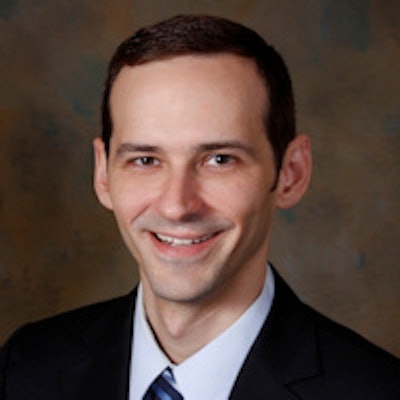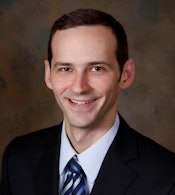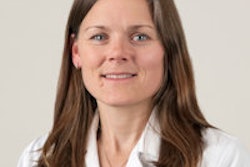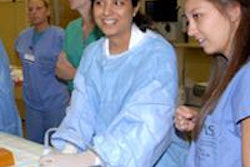
Residents are as effective as radiologists in teaching medical students about radiology, according to a new study in the Journal of the American College of Radiology. The findings suggest that medical schools might want to consider including more residents as teachers.
The study compared evaluation scores given by medical students for faculty members, fellows, and residents who taught radiology core courses over a one-year period. The results showed no statistical difference between the evaluations for faculty and residents -- in fact, residents' scores trended slightly higher.
Residents received similar scores across the board, explained Dr. David Naeger and colleagues from the University of California, San Francisco (UCSF). "Given that teaching can be an educational experience for residents, involving radiology residents in medical student teaching may benefit students and residents alike" (JACR, September 26, 2013).
Perhaps no surprise?
Naeger is an assistant professor of clinical radiology at UCSF and director of the core medical student radiology course. Speaking by telephone with AuntMinnie.com, he said he wasn't surprised that UCSF residents who are motivated and in many cases "amazing teachers" performed so well.
"It turns out that our very engaged residents scored the same as our very engaged faculty, so I think the most important conclusion was that in this setting, with mentorship and guidance, residents can be evaluated very similarly to attendings when teaching medical students," he said.
 Dr. David Naeger from UCSF.
Dr. David Naeger from UCSF.
Teaching medical students is vital to radiology because some students will choose the specialty after being exposed to preclinical and clinical radiology content in courses and clerkships, the authors wrote. Teaching experience also goes hand in hand with the new, more visible role of radiologists. Even students who don't choose radiology often become referring physicians who interact daily with their radiology colleagues.
The need for high-quality instruction remains strong -- often stronger than the supply of teachers, because the most-experienced instructors face many competing demands, such as pressure from research, clinical practice, and grant funding activities due to financial considerations. So it's important to tap the teaching talent you have, Naeger said.
But not all residents get a chance to try it. Some residency programs have implemented formal "resident-as-teacher" criteria; however, others have done little to promote it, despite the inclusion of teaching skills in the Accreditation Council for Graduate Medical Education's (ACGME) description of practice-based learning and improvement as a core competency, the authors wrote.
Although there has been much research of resident-as-teacher programs, little has been published comparing residents' teaching skills to those of radiologists, Naeger and colleagues wrote. But extensive feedback data are available, and the information can be used to compare the teaching skills of residents versus faculty members.
"Given our generally positive experience with residents as teachers, we hypothesized that residents would be evaluated as similar to attending radiologists in their lecture scores," the authors wrote.
The research team gathered data over a single year for lectures given during a radiology clerkship elective for fourth-year medical students. The elective includes 50 hours of lecture, along with assignments, self-study activities, and nonlecture activities such as tours, hands-on sessions, and small-group sessions. In the past, radiology faculty taught the course, but residents have been increasing their participation in recent years.
All residents who participated in teaching were mentored by faculty members, with enough mentoring to ensure their improvement over time, Naeger and colleagues wrote. Each lecture was evaluated by attendees as a requirement of attendance on a scale of 1 (poor) to 10 (excellent). Attendees were also asked to provide free-text comments, though these were not used in the current study.
Each lecture score was a single data point, identified only by the status of the lecturer: attending radiologist, fellow, or resident. Over the 2011-2012 academic year, 31 attending faculty members, 12 fellows, and 22 residents lectured an average of 5.7 hours each.
In all, students scored a total of 307 lectures over six course offerings, providing mean scores of 9.10 ± 0.60 for faculty members, 8.99 ± 0.49 for residents, and 8.45 ± 0.90 for fellows.
Residents and faculty equal, fellows less so
There was an overall statistically significant difference in scores for the three groups as determined by an analysis of variance (p < 0.001), according to the authors. The difference was primarily due to significantly lower scores for fellows as a group, compared with faculty members and residents (p < 0.001 for both); there was no significant difference between faculty members and residents (p = 0.089).
Certainly residents and faculty are different groups of people with different strengths who are not interchangeable, Naeger said. Also, an important point for the study is that residents received help others did not.
"There are certainly differences," he said. "The first huge point is that every resident who was instructing in the course got a lot of guidance and help in their teaching, whereas faculty did not. That's required by the guidelines and it's ethically appropriate because they're our trainees, and there's no way to do this study without helping them. So in that sense it's a little unfair, because one group had teaching assistance and the other group just went on their own, which might have helped level the playing field."
Fellows were the smallest group, and the way they participated differed from the other groups, Naeger said. Unlike the other instructors, fellows were assigned to give premade presentations, for which they weren't mentored.
Fellows tended to give fewer lectures -- 27 of 307 lectures analyzed in the study -- and they may have been less invested in their lecture performance and improvement because they were assigned to do it. This may have been an important factor in their slightly lower scores.
All-volunteer teaching
Going forward, the program decided to move to an all-volunteer teaching group composed of residents and faculty and excluding fellows, Naeger told AuntMinnie.com.
While it's laudable that residents fared as well as faculty members, is teaching truly a good use of their time?
"We consider teaching a useful skill, regardless of career path," the authors wrote. "Therefore, if residents are guided and actively engaged in teaching, the experience could be beneficial to residents and students alike." Programs should make full use of residents as teachers but also "provide formal mechanisms for residents to learn teaching skills."
Importantly, residents should not be used as the primary educators in medical student electives, particularly without abundant supervision and feedback, the group added.
"Even if they can be good lecturers, residents should never be the backbone of the course, and they're not the backbone of our course," Naeger said. "Plenty of faculty members helped set the structure, helped fill in the gaps, and gave lectures that only faculty can give. So residents scored very highly, but in a setting with a lot of faculty involvement in structure."



















